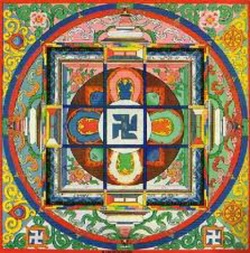About Bon Buddhism
Bon is Tibet’s oldest spiritual tradition. It includes teachings and practices applicable to all parts of life, including our relationship with the elemental qualities of nature; our ethical and moral behavior; the development of love, compassion, joy and equanimity; and Bon's highest teachings of the “Great Perfection,” dzogchen. According to the traditional Bon account of its origins, many thousands of years before the birth of the Buddha Shakyamuni, the Buddha Tonpa Shenrab Miwoche came to this world and expounded his teachings in the land of Olmo Lungring. "Ol" symbolizes the unborn, "mo" the undiminishing, "lung" the prophetic words of Tonpa Shenrab and "ring" his everlasting compassion. Some modern scholars have identified Olmo Lungring with Zhang Zhung, the country surrounding Mount Kailash in western Tibet and the cradle of Tibetan civilization.
Tonpa Shenrab is said to have taught Bon in three successive cycles of teachings. First he taught the “Nine Ways of Bon”; then he taught the “Four Bon Portals]] and the Fifth, the Treasury”; and finally he revealed the “Outer, Inner and Secret Precepts.” In the final cycle of teachings the outer cycle is the path of renunciation, or sutric teachings; the inner cycle is the path of transformation, or tantric teachings; and the secret cycle is the path of self-liberation, or dzogchen teachings. This division into sutra, tantra and dzogchen is also found in the Nyingma school of Tibetan Buddhism. Followers of Bon receive oral teachings and transmissions from teachers in a lineage unbroken from ancient times until the present day. In addition, most of the scriptural texts also have been preserved. While much in modern Bon is similar to Tibetan Buddhism, Bon retains the richness and flavor of its pre-Buddhist roots.
Until very recently, the ancient teachings of Bon were offered to very few students of any generation. Now, its lamas are reaching out to teach fortunate Western students about the rich Bon spiritual tradition and its practices.
Through the ceaseless efforts of His Holiness Lungtok Tenpai Nyima Rinpoche, the 33rd abbot of Menri; and Yongdzin Tenzin Namdak Rinpoche, senior teacher of the Bon tradition; two new monasteries have been built outside of Tibet. Tashi Menri Ling Monastery, first built in Tibet in 1405, has been reestablished in Dolanji, India. Triten Norbutse Monastery, first built in Tibet in the 14th century, has been reestablished in Kathmandu, Nepal.
Both monasteries have schools that are qualified to give geshe (doctoral) degrees. Menri Monastery also has an elementary school through eighth grade and an orphanage for more than 150 boys and girls. Both monasteries provide a modern-day source of Bon culture, scholarship and compassion in action.
